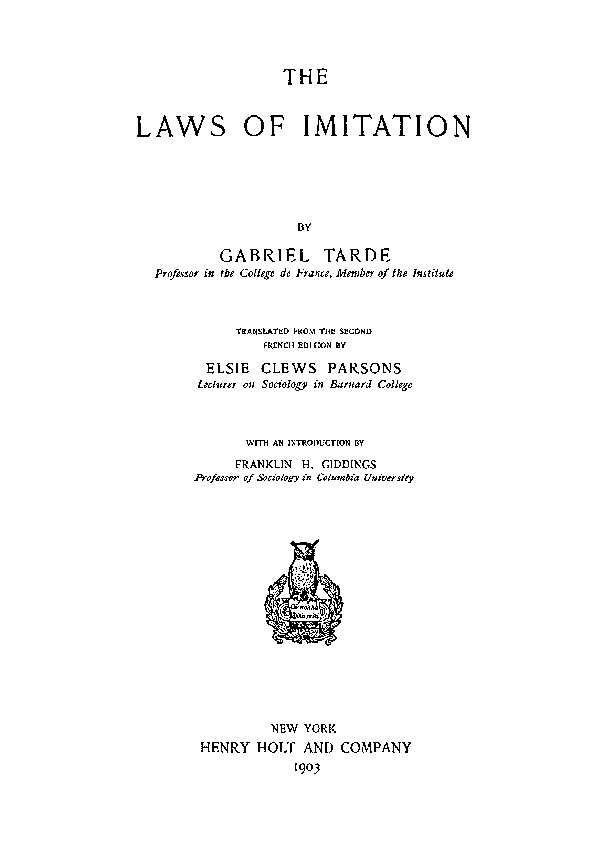Hillel Schwartz: The Culture of the Copy: Striking Likenesses, Unreasonable Facsimiles, 2nd ed. (1996/2013)
Filed under book | Tags: · animal, appropriation, art, children, computing, copy, death, fashion, film, gender, genetics, history, imitation, japan, language, machine, memory, music, photography, piracy, property, reenactment, reproduction, sculpture, simulation, slavery, statistics, surgery, technology, theatre, time, war

The Culture of the Copy is an unprecedented attempt to make sense of the Western fascination with replicas, duplicates, and twins. In a work that is breathtaking in its synthetic and critical achievements, Hillel Schwartz charts the repercussions of our entanglement with copies of all kinds, whose presence alternately sustains and overwhelms us. Through intriguing, and at times humorous, historical analysis and case studies in contemporary culture, Schwartz investigates a stunning array of simulacra—counterfeits, decoys, mannequins, and portraits; ditto marks, genetic cloning, war games, and camouflage; instant replays, digital imaging, parrots, and photocopies; wax museums, apes, and art forgeries, not to mention the very notion of the Real McCoy. Working through a range of theories on biological, mechanical, and electronic reproduction, Schwartz questions the modern esteem for authenticity and uniqueness. The Culture of the Copy shows how the ethical dilemmas central to so many fields of endeavor have become inseparable from our pursuit of copies—of the natural world, of our own creations, indeed of our very selves.
This updated edition takes notice of recent shifts in thought with regard to such issues as biological cloning, conjoined twins, copyright, digital reproduction, and multiple personality disorder. At once abbreviated and refined, it will be of interest to anyone concerned with proglems of authenticity, identity, and originality.
First published in 1996
Publisher Zone Books, New York, 2013
ISBN 1935408453, 9781935408451
480 pages
Review (Terence Hawkes, London Review of Books, 1997)
Review (Francis Kane, The New York Times, 1997)
Review (Todd Gitlin, Los Angeles Times, 1997)
Download (removed on 2014-3-20 upon request of the publisher)
Comment (1)Gabriel Tarde: The Laws of Imitation (1890/1903) [French/English]
Filed under book | Tags: · archaeology, criminology, imitation, invention, philosophy, psychology, society, sociology, somnabulism

“Among the phenomena that early arrested his attention was imitation. From his office of magistrate he observed the large part that imitation plays in criminal conduct. Does it play a smaller part in normal conduct? Very rapidly M. Tarde’s ardent mind ranged over the field of history, followed the spread of Western civilisation, and reviewed the development of language, the evolution of art, of law, and of institutions. The evidence was overwhelming that in all the affairs of men, whether of good or of evil report, imitation is an ever-present factor; and to a philosophical mind the implication was obvious, that there must be psychological or sociological laws of imitation, worthy of most thorough study. [..] Tarde perceived that imitation, as a social form, is only one mode of a universal activity, of that endless repetition, throughout nature, which in the physical realm we know as the undulations of ether, the vibrations of material bodies, the swing of the planets in their orbits, the alternations of light and darkness, and of seasons, the succession of life and death. Here, then, was not only a fundamental truth of social science, but also a first principle of cosmic philosophy.” (from the Introduction)
Les lois de l’imitation: étude sociologique
Publisher Félix Alcan, Paris, 1890
432 pages
English edition
Translated from the second French edition by Elsie Clews Parsons
With an Introduction by Franklin H. Giddings
Publisher Henry Holt and Company, New York, September 1903
404 pages
announcement (The New York Times, 1903)
google books [French]
google books [English]
PDF [French]
PDF [English]
PDF (more formats) [English]

